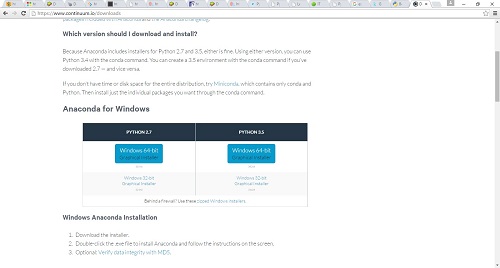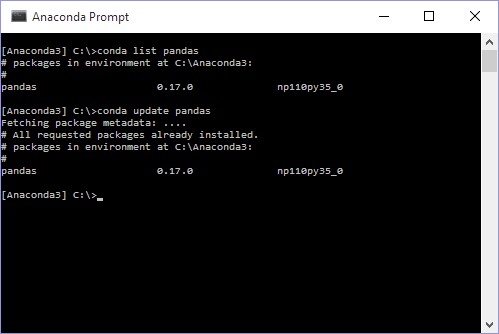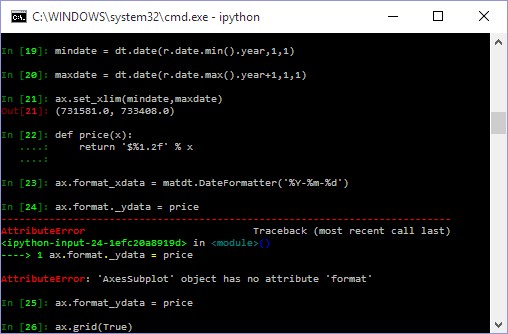Panda Numpy Scipy Data Scientist Can Focus on Other
Acme v Libraries for Data Science in Python
If y'all are an aspiring data scientist- always learning, exploring and playing with information and then this weblog post will help you become fix to begin your career in information science with Python. Python Language has a rich and salubrious ecosystem with ample of libraries for data analysis, information I/O and information munging. The best fashion to make sure that you are all ready to go a information scientist is to make yourself well-versed with the various Python libraries and tools that people utilize in the industry for doing data scientific discipline. We asked our information science faculty to list five Python libraries for information science that they think every information scientist must know how to use. Bank check them out below:

Skip Gram Model Python Implementation for Word Embeddings
Downloadable solution lawmaking | Explanatory videos | Tech Back up
Explore Project
Table of Contents
- Python Libraries for Data Science
- 1) Pandas
- 2) NumPy
- 3) SciPy
- iv) Matplotlib
- 5) Sci-Kit Learn
Python Libraries for Information Scientific discipline

1) Pandas
All of u.s. tin easily do some kind of data analysis using pen and paper on small data sets. Imagine a situation, where nosotros have to clarify millions of petabytes of information. Nosotros would require specialized tools and techniques to analyze and derive meaningful information from huge datasets. Pandas Python is one of those libraries for data assay, that contains high-level information structures and tools to help data scientists or data analysts manipulate data in a very elementary and easy way.
To provide a very uncomplicated and notwithstanding effective way to analyze data requires the ability to index, retrieve, divide, join, restructure and diverse other assay on both multi and unmarried dimensional information. Pandas information analysis library has some unique features that provide these capabilities-
i) The Series and DataFrame Objects
These two are high performance array and table structures, for representing the heterogeneous and homogeneous data sets in Pandas Python.
ii) Restructuring of Data Sets
Pandas python provides the flexibility for reshaping the data structures and so that the data can be inserted in both rows and columns of tabular information.
three) Labelling
To let automatic alignment of data and indexing, pandas provides labelling on series and tabular data.
4) Multiple Labels for a Data Item
Heterogeneous indexing of data spread beyond multiple axes, which helps in creating more than one label on each data item.
v) Group
The functionality to perform divide-use-combine on serial as well on tabular data.
vi) Identify and Ready Missing Data
Using pandas, programmers can hands identify and mix missing data in both floating and not-floating pointing numbers.
vii) Powerful capabilities to load and save data from various formats such as JSON, CSV, HDF5, etc.
8) Conversion from NumPy and Python data structures to pandas objects.
9) Slicing and sub setting of datasets, which include merging and joining information sets with SQL- like constructs.
Although, pandas provides many statistical methods, it merely is not plenty for doing information science in Python. Pandas depends upon other python libraries for information scientific discipline similar NumPy, SciPy, Sci-Kit Acquire, Matplotlib, ggvis in the Python ecosystem to draw conclusions from big data sets. Thus, making it possible for Pandas applications to take advantage of the robust and extensive Python framework.
Get Closer To Your Dream of Becoming a Data Scientist with 70+ Solved End-to-Finish ML Projects
Installation of Pandas
There are many people who often say that "Python is astonishing for doing information science but they take spent 3 days installing Python and other libraries to learn doing data science in Python." It is non recommended to install the PyData stack manually particularly when one does not know which libraries they will really need. If you are one among them, then Anaconda past Continuum is for you.
Anaconda, is one of the most popular Python distribution offering both paid and free components. Anaconda is very popular among the open source community because of its cross-platform support to run on Windows, Mac or Linux
The base package of Anaconda installs pandas as a part of the default installation process, which makes it piece of cake to begin using pandas. The default installation likewise installs IPython Notebook server, which tin can be used to run the applications interactively.
Excited? Now, let's install Anaconda and pandas, to write some absurd stuff!!
How to install Anaconda?
You tin can download the latest Anaconda from the Continuum Analytics website https://world wide web.continuum.io/downloads. Once yous visit the website, it will automatically detect the Bone and provide you lot with unlike options for downloading.

Installing Anaconda
After downloading the installer, Windows organization provides the executable as shown below-

Later executing the installer and the screen volition guide yous to install Anaconda, simply follow the on screen commands and finish the installation process.

Later on the installation process is completed, open up the control prompt and type python, the below screen volition appear on successful installation of Python -

Now since Anaconda is installed successfully, we need to bank check, if pandas installed is the most recent version or not. Pandas version can be verified using conda parcel manager from the command line equally follows-
conda list pandas

If the pandas version installed is not a recent i, then use the beneath command to update Pandas-
conda update pandas
This control volition download the latest version of pandas and all its dependencies every bit follows-

Example on Using Pandas DataFrame object
We volition write our offset application in IPython interpreter, as it provides a very convenient way for writing Python applications.
Open the control prompt and type ipython as shown below-

In [1]: import pandas as pd
In [two]: mydf = pd.DataFrame.from_items ([('column1', [1, two, 3])])
In [iii]: print (mydf)
Output for the above lawmaking:
column1
0 1
ane 2
2 3

That's it! Information technology's very easy to write pandas applications using IPython. We can also write using the web based GUI of IPython Notebook.
2) NumPy
Numerical Python lawmaking proper name: - NumPy, is a Python library for numerical calculations and scientific computations. NumPy provides numerous features which can be used past Python enthusiasts and programmers to work with high-performing arrays and matrices. NumPy arrays provide vectorization of mathematical operations, which gives information technology a performance heave over Python's looping constructs.
pandas Series and DataFrame objects rely primarily on NumPy arrays for all the mathematical calculations like slicing elements and performing vector operations. Below are some of the features provided by NumPy-
- Integration with legacy languages.
- Mathematical Operations: Information technology provides all the standard functions required to perform operations on large data sets in a very fast and efficient style, which otherwise accept to exist performed through looping constructs.
- ndarray: Information technology is a fast and efficient multidimensional array which tin perform vector based arithmetics operations and has powerful broadcasting capabilities.
- I/O Operations: It provides various tools which can be used to write/read very large data sets from deejay. It also supports I/O operations on memory based file mappings.
- Fourier transform capabilities, Linear Algebra and Random Number Generation.
Installation of NumPy
If you accept installed Anaconda as mentioned above, and then NumPy will get installed automatically, as it is ane of the dependency of pandas. But, in instance yous have downloaded information technology via some other tools, then yous need to download NumPy separately, after installing Python. Also, y'all demand to keep in mind that, NumPy has to be installed first and and so any other add-ons can be installed.
Fundo Stuffs in NumPy
Arrays Operations
i) Cosmos of Arrays
Open command prompt and type ipython. Then blazon below commands
In [1]: import umpy equally np
In [2]: myarray = np.assortment([7,four,3,viii,9],int)
In [3]: myarray
Out[three]: array([7, iv, three, 8, 9])

ii) Slicing An Array
In [5]: myarray[:2]
Out[v]: assortment([seven, 4])

iii) Accessing elements from Array
In [half-dozen]: myarray[3]
Out[half dozen]: 8

four) Converting Array to a binary string
In [i]: import numpy every bit np
In [2]: myarray = np.assortment([4,5,7,viii],int)
In [three]: mystring = myarray.tostring()
In [four]: mystring
Out[four]: b'\x04\x00\x00\x00\x05\x00\x00\x00\x07\x00\x00\x00\x08\x00\x00\x00'

Phew!!! Those were some cool commands, allow's motility forward to our side by side Python library in the list.
three) SciPy
Scientific Python code proper noun, SciPy-It is an array of mathematical functions and algorithms which are built on meridian of Python'south extension NumPy. SciPy provides diverse high-level commands and classes for manipulating and visualizing data. SciPy is useful for data-processing and prototyping of systems.
Apart from this, SciPy provides other advantages for building scientific applications and many specialized sophisticated applications that are backed by powerful and fast growing Python community.
Installing SciPy
Equally we are using Anaconda for installing Python modules and running the commands, for SciPy too we will be using Anaconda. Being a dependency for pandas, SciPy also gets installed with the default installation of Anaconda. For Python lovers, SciPy is also available for downloading separately using this http://www.scipy.org/install.html link.
Exploring the Ability of SciPy with some Examples-
Linear Algebra
i) Creating an array
In [1]: import numpy every bit np
In [2]: import scipy every bit sp
In [iii]: import scipy.linalg every bit spalg
In [4]: myarray1 = np.array([[1,2],[iii,4]])
In [half-dozen]: myarray1
Out[6]:
assortment([[1, 2],
[3, 4]])

2) Calculating the Changed of an Array
In [vii]: spalg.inv(myarray1)
Out[seven]:
array ([[-2. , ane. ],
[ 1.5, -0.5]])

iii) Matrix Multiplication
In [8]: myarray2 = np.assortment([[5,half-dozen]])
In [xi]: myarray1.dot(myarray2.T)
Out[xi]:
array([[17],
[39]])

Awesome!!! We have just accept completed 3 almost popular libraries of Python for information scientific discipline and information technology's time to go ahead with the next one.
iv) Matplotlib
Nosotros all accept heard this quote "Necessity is the mother of all invention". The aforementioned holds true for matplotlib. This open source project was adult to handle different types of data generated from multiple sources in the epilepsy. matplotlib is a 2D graphical Python library. Yet, it also supports 3D graphics, but this is very limited. With increasing demand for Python in many folds in the contempo years, growth of matplotlib has given tough competition to giants like MATLAB and Mathematica.
Installation of Matplotlib
You might exist very happy to hear this that, when you installed Anaconda, matplotlib has also got installed under default installation. So, you practise non demand to do any extra installation. For knowledge seekers who want to build through the source code of Matplotlib, visit http://matplotlib.org/users/installing.html.
Time to practice Some Plotting using Matplotlib
Demo for creating appointment plots, loading a default Yahoo csv file which comes with default installation.
In [1]: import datetime as dt
In [two]: import numpy as np
In [3]: import matplotlib.pyplot as matpy
In [four]: import matplotlib.dates every bit matdt
In [5]: import matplotlib.cbook every bit cbook
In [6]: yrs = matdt.YearLocator()
In [7]: mnt = matdt.MonthLocator()
In [8]: yrsFmt = matdt.DateFormatter('%Y')
In [9]: dataFile = cbook.get_sample_data('goog.npy')
In [10]: try:
r = np.load(dataFile,encoding='bytes').view(np.recarray)
except TypeError:
r = np.load(dataFile).view(np.recarray)
In [13]: fig,ax = matpy.subplots()
In [14]: ax.plot(r.date,r.adj_close)
Out[14]: []
In [15]: ax.xaxis.set_major_locator(yrs)
In [sixteen]: ax.xaxis.set_major_formatter(yrsFmt)
In [17]: ax.xaxis.set_minor_locator(mnt)
In [nineteen]: mindate = dt.appointment(r.date.min().year,1,one)
In [20]: maxdate = dt.date(r.date.max().twelvemonth+1,ane,one)
In [21]: ax.set_xlim(mindate,maxdate)
Out[21]: (731581.0, 733408.0)
In [22]: def cost(x):
return '$%1.2f' % x
In [23]: ax.format_xdata = matdt.DateFormatter('%Y-%m-%d')
In [25]: ax.format_ydata = price
In [26]: ax.filigree(True)
In [27]: fig.autofmt_xdate()
In [28]: matpy.show()




Once the concluding command matpy.bear witness () is executed, a pop-upwardly window will appear with the outcome every bit shown below-

With some basic coding and commands yous are able to create a visual graph based on the data, imagine the brilliance and power of matplotlib.
5) Sci-Kit Learn
For all the machine learning practitioners who want to bring machine learning into the production systems, Sci-Kit Learn is the savior, Sci-Kit Learn has several supervised and unsupervised automobile learning algorithms which have a level of robustness and support required for utilise in production applications. As this library provides various learning algorithms, it has been named as Sci-Kit Acquire. Sci-Kit Learn focuses on code quality, good documentation, ease of utilise and performance.Sci-Kit Learn has a steep learning bend.
Installation of Sci-Kit Acquire
Sci-Kit Larn is built upon SciPy and thus to employ Sci-Kit Acquire it is necessary to install diverse other Python libraries – Pandas, NumPy, SciPy, SymPy and IPython (the enhanced interactive console).However, on installing Anaconda-Sci-Kit Acquire is also installed by default.
At the first of this article you lot might accept heard simply well-nigh the popular libraries in python for data science but now yous can practice some bones coding and make wonders using Python libraries with your datasets. Python ecosystem is a huge ocean with and then many libraries to exist unleashed for data scientists. These were simply few of them. Subscribe to our blog for more updates on exploring other Python libraries.

staplersaitheitring.blogspot.com
Source: https://www.projectpro.io/article/top-5-libraries-for-data-science-in-python/196
0 Response to "Panda Numpy Scipy Data Scientist Can Focus on Other"
Post a Comment